We’ve got a special treat today here at FIRESTORM FAN – a fantastic interview with celebrated Firestorm writer, John Ostrander!

John Ostrander wrote 45 issues of FIRESTORM vol II from 1987 through 1990. Besides Firestorm co-creator Gerry Conway, Ostrander has written the character more than any other author. The dramatic changes Ostrander introduced to Firestorm generated lots of positive buzz. Thanks to Ostrander’s bold new direction and creativity, change has become an integral part of the Firestorm character.
John Ostrander started in the comic book business in 1983 and was incredibly successful. By 1987 he was writing five different monthly titles! He is best known for his work on SUICIDE SQUAD, GRIMJACK, THE SPECTRE, and STAR WARS: LEGACY. Ostrander has written hundreds of fantastic comics and was nominated for the Comics Buyer’s Guide Award for Favorite Writer in 1997, 1998, 1999, and 2000. Probably his most lasting contribution to the DC Universe was the recasting of the former Batgirl, Barbara Gordon, into the information and computer specialist Oracle. Currently he is working on STAR WARS LEGACY: WAR from Dark Horse Comics.
John was kind enough to spend some time discussing his run on Firestorm with FIRESTORM FAN.
THE EARLY YEARS
FIRESTORM FAN: John, how did you first get interested in reading comics and what were some of your favorites?
JOHN OSTRANDER: Well, my boyhood was during the Fifties and my mother was convinced, thanks to Doctor Wertham and the article Seduction of the Innocent, that comic books were quite bad for you so, of course, I had to find them and read all of them that I could. I was in Catholic school and they did have a monthly comic book there called TREASURE CHEST, that was approved and there actually were some good stories in it and which I still remember. Of the forbidden fruit, I remember liking the BLACKHAWKS a lot and BATMAN. Real keen on CHALLENGERS OF THE UNKNOWN, which I still think is a GREAT title for a comic. I later discovered Marvel with issue 49 of THE AMAZING SPIDER-MAN and read all of those that I could. Loved and learned a lot from Kirby and Lee, especially on the FANTASTIC FOUR. Denny O’Neil and Neal Adams on GREEN LANTERN/GREEN ARROW was a revelation to me in college. More realistic art and the stories wove social issues into dynamic superhero action.
FF: You started your career at First Comics in 1983 writing books such as WARP, STARSLAYER, and GRIMJACK. Within just a few years, you were working for major publishers writing as many as five monthly comics all at the same time. What attracted you to writing comics and how would you describe your early experiences?
JO: Oh, I had long wanted to write comics. I’d been in theater and had already written a few plays. I’d been a great reader and I wanted to give back to that from which I had gotten so much pleasure. Making a living from it was just astounding to me. The early experiences were learning ones. Mike Gold, my old friend and the editor in chief at First Comics called me up one day and asked me if I’d like to try and write an 8 page backup for the adaptation of the play WARP that they were going to do. I was a big fan of the play so I submitted things and Mike kept correcting it and sending it back to be re-worked until, finally, he announced that my story was going to be in the back of their first issue of WARP. “Oh,” I said, “that’s cool. Ummmm, do I get PAID for it?” Mike told me I was an idiot and YES, I was going to be paid. Thus began my career.
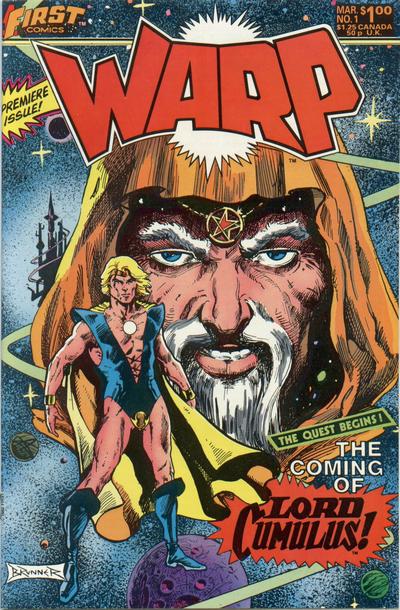
FF: Your first work at DC was in 1986 writing a major company crossover entitled LEGENDS. What brought you to DC and such a high profile assignment?
JO: Again, it was Mike Gold. He had gone to DC and one of his first projects was a follow-up to CRISIS ON INFINITE EARTHS. He wanted a new voice to add something to the project and I got coupled with a DC heavy, Len Wein, on the project. From that followed my DC career. Including Firestorm.
FIRESTORM YEARS
FF: How did you get the Firestorm assignment?
JO: Gerry Conway, the creator, didn’t want to do the tie-ins with LEGENDS that the book was going to have so it was suggested that, since I knew what was going on in LEGENDS, that I write them. Afterwards, Gerry came back for a few issues but decided it was time to move on. Denny O’Neil, who was now the editor of the book, liked my fill-ins and turned the book over to me. So started my Firestorm run.
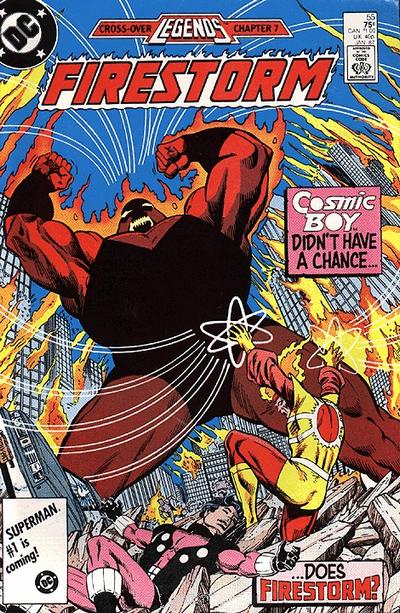
FF: Your Firestorm adventures took the character in a very different direction than the previous writer. Was the change in direction intentional or was it simply a by-product of the stories you wanted to tell?
JO: I think that if you switch the writer, the new one SHOULD take the character in a different direction of some kind, inject some fresh ideas and fresh energy into the book. There should be respect for the continuity but one shouldn’t be chained to it. The book wasn’t doing especially well in sales at the time and I was given six months to boost its numbers. We did well enough to keep running for a while.
FF: What aspects of Firestorm did you enjoy writing the most? What aspects did you find the most challenging to write?
JO: What annoyed me to start was how Ronnie jerked around Martin’s life. Martin didn’t know he was part of the Firestorm matrix and when Ronnie formed Firestorm, Martin had no memory of it. He thought it was blackouts or something. It wrecked his career and much of his life. So that was a challenge that had to be addressed. I liked the concept of Firestorm, however – two separate beings combining to become one superhero – and the fact that Firestorm could manipulate energy. That was always interesting to play with. And I liked several of the supporting cast members as well.
FF: You introduced a lot of interesting supporting characters to the Firestorm title. Folks like Mikhail Arkadin, the kids of Soyuz, the Institute for Metahuman Studies, the Captains of Industry, Rasputin, Shadowstorm, the Black Gods, and many more. Were there any of them you enjoyed writing more than others?
JO: Mikhail Arkadin really shook up the status quo on the book and that was great. I liked Soyuz a lot. I’d always wanted to play with the Black Gods (a result of my reading African mythology and folk tales). The Captains of Industry was an interesting idea, I think, but I don’t think my execution was all it might have been. Not really well thought out.
FF: Were there any characters you discovered you didn’t really care for?
JO: A lot of the older villains didn’t do much for me which is why I didn’t use a lot of them.
FF: On several occasions, supporting characters from one of your books would crossover into another of your books. For example, Doctor Simon LaGrieve was a regular in both FIRESTORM and SUICIDE SQUAD. Many of the Suicide Squad members were originally Firestorm villains. It’s almost like you had your own cool little corner of the DC universe. Was there any motivating reason you kept your books so inter-connected? Did breaking into DC with Legends influence you to produce crossovers more regularly?
JO: I liked universes that had characters from one book crossing into another even on an informal basis. I always thought that was a good idea and more fun for the reader. Also, in Suicide Squad, we had a tendency to kill of baddies now and then. You couldn’t always go to another book’s writer or editor and say, “I’d like to use so and so and kill them off. Do you mind?” Whereas on Firestorm, I controlled that book. And if I wasn’t willing to kill off some of my cast, why would anyone else let me do it?
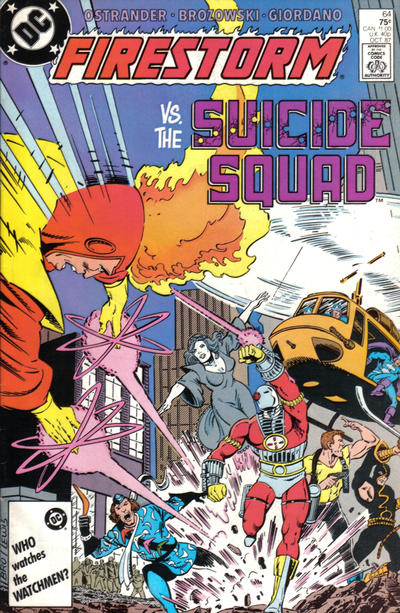
FF: While working on the Firestorm character, you had the opportunity to work with some great artists like Joe Brozowski, Ross Andru, Tom Grindberg, and Tom Mandrake. Each artist had their own distinctive look. What were some characteristics that different artists brought to your Firestorm stories? Did you write full-script or plot-first, and how collaborative were your relationships with the artists?
JO: As I recall, it was generally plot-first. I might consult with the artist if there was a big change or some new character. If they had some thoughts, I was willing to listen to them and incorporate those ideas if I felt I could. Mostly, however, I wrote and they drew. As you said, each artist brought something unique to the work and I enjoyed working with them all. Mandrake is also a great friend and I enjoyed working with him a lot. I always do.
FF: Do you have any favorite issues or storylines from your time on Firestorm?
JO: I really enjoyed the storyline leading up to the “death” of Martin Stein and our first revamped visual on Firestorm which wound up in the Annual that year. Martin’s later return was also a favorite of mine. The Black Gods story. I haven’t read the books in a long time so it’s a little hard to pick out others.

FF: Your run on Firestorm can be divided into the “Blank Slate” era and the “Elemental” era. Do you feel a stronger connection to one or the other? Is one Firestorm more “your” character than the other?
JO: Not really. It was a means of evolving the character. The “elemental” Firestorm gave me a look I preferred.
FF: You inherited from the previous writer the subplot of Professor Stein dying from cancer. Was it decided from the start to let the cancer storyline run its course, or were there discussions on how to “cure” Stein?
JO: No. Gerry Conway and I never had a conversation as to where he was headed with that subplot. I decided that if it was a given that Stein had brain cancer and it was inoperable, that we should just follow that to its logical conclusion. At the time, I had no intentions of bringing Martin Stein back.
FF: Leading up to the introduction of the Blank Slate Firestorm, editor Denny O’Neil made several references in the letter columns to your master plan to transform Firestorm. When you developed this storyline, was it planned all along for the Blank Slate Firestorm to eventually become the Elemental, or did that idea come about later?
JO: The Elemental Firestorm came later. The blank slate was what Denny was referring to.
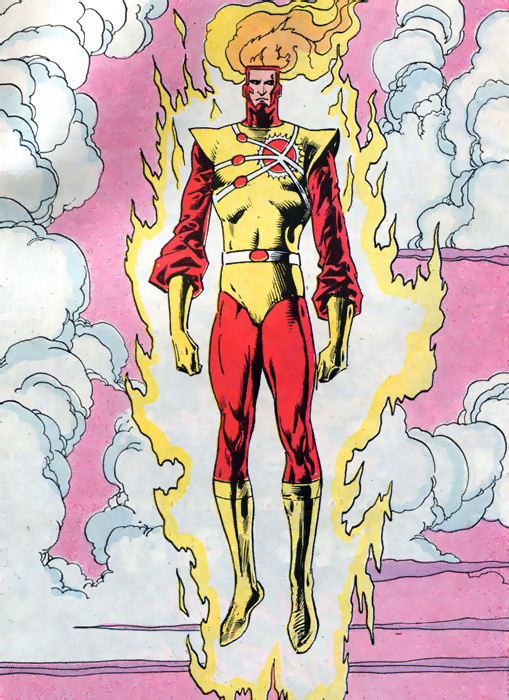
FF: What was the inspiration for the Elemental Firestorm? And what input did you have on character design?
JO: At the time, Swamp Thing had developed into the Earth Elemental. In mythology, the elements were defined as Earth, Air, Water, and Fire. I think they had already decided that Red Tornado was actually the Wind Elemental so it seemed logical (to me at least) that Firestorm was the Fire Elemental. Tom and I had conversations, as I recall, about the new look. Guilty confession – while I liked Firestorm having fire for hair, I felt the original look made him look like a Bunsen Burner. The flowing fiery mane was a lot cooler, IMO. I also liked bare feet – it made him look more primitive, more “elemental”.
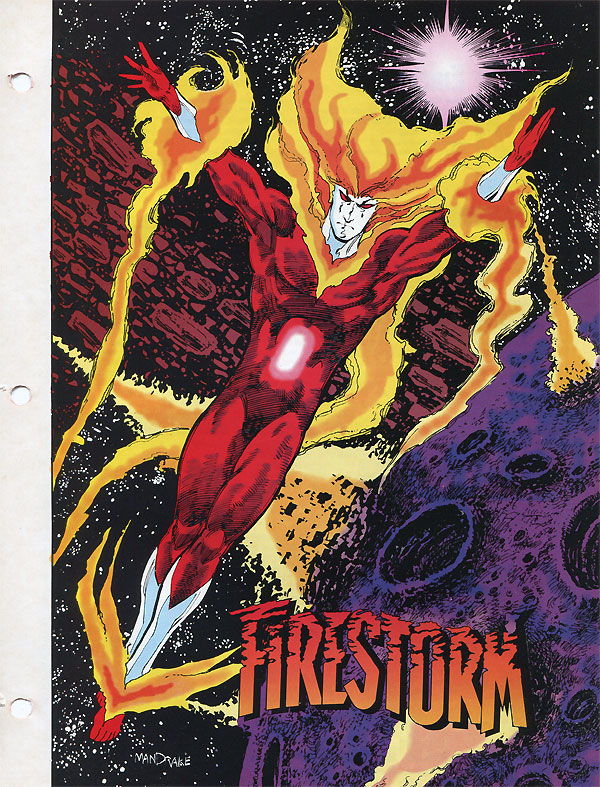
FF: On more than one occasion, your Firestorm stories included elements of African culture – The Eden storyline and the Black Gods storyline. What spawned your interest in African culture?
JO: As I said earlier, I’d read lots of African mythology as well as other mythologies around the world. I was always struck by how powerful the stories were. There were pantheons and gods as interesting and varied as the Norse or Celtic and yet very few people had heard of them. I tweaked it a bit for the comics medium, yeah, but the characters and some of the stories are real close to what I had read and learned.

FF: The character of Rasputin was one of your more enigmatic supporting characters. He went on to appear in your Captain Atom issues after the Firestorm series ended. Just to satisfy my fanboy curiosity, did you envision him as the original Grigori Rasputin that advised the Romanov dynasty or was he something else all together?
JO: Good question. Let’s just leave it enigmatic. 
FF: There was a noticeable level of maturity displayed within your Firestorm run. While most series in the late 80s featured a villain-of-the-month, Firestorm was regularly tackling socially relevant subjects. Some of the letter writers published compared the Elemental run of Firestorm to mature reader titles such as Sandman, Animal Man, Green Arrow, and The Question. What feedback did you receive at the time about the maturity of these storylines? And was there any consideration given towards making Firestorm a mature reader title back then?
JO: I don’t think there was a necessity then or now for it to be labeled “mature readers”. The label usual meant nudity, profanity, or extreme violence and Firestorm didn’t have any of that. I wrote on topics that interested me, that I thought would make good stories. It harkened back to Denny O’Neil’s run on GREEN LANTERN/GREEN ARROW which fused social consciousness with great superhero stories. Denny, as editor, later advised me that our first job was telling a good story. We can say anything we want but first we have to tell a good story. That’s what the folks pay their money for. I wasn’t looking to be “relevant”, I was looking to make the stories more interesting, to relate it to the world around us, to what was happening at the time. All because I felt it would make a better STORY.
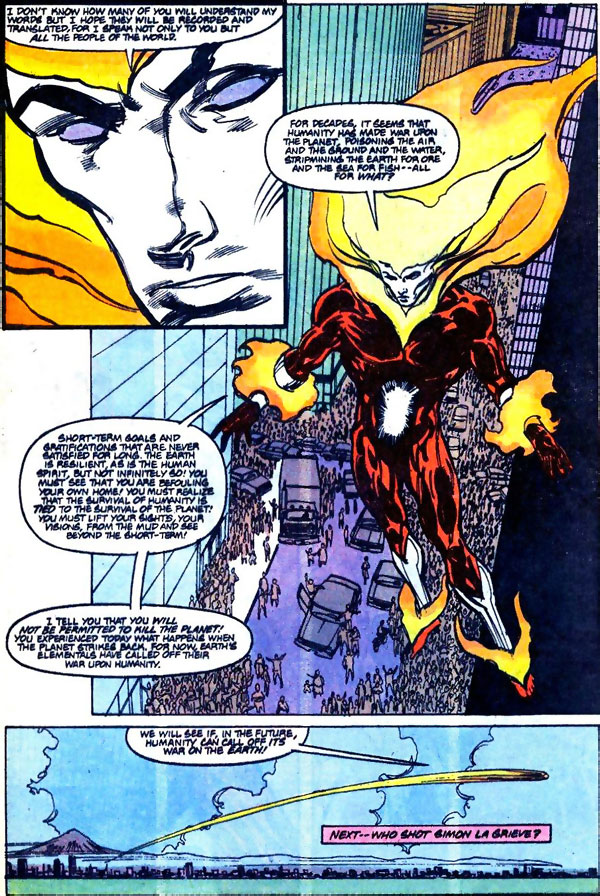
FF: What non-comic material were you reading back then? How did you stay current on the social issues you addressed in your books?
JO: I’m an avid reader. I still read at least one newspaper every day, plus magazines, and, these days, news blogs. I listen to news on the radio. I’ve read history and biography and, if a topic interests me enough to do a story with it, I’ll do some research. Same was true back then. Read, see what catches my eye, look into it a bit.
FF: The villain Brimstone appeared in your very first Firestorm story as well as your last. Did you choose him intentionally for your final issue to serve as a sort of bookend?
JO: I honestly don’t remember. It’s not unlikely but I just can’t swear that was consciously in my mind.
FF: FIRESTORM #100 was your final issue. You wrote a very nice letter in the back explaining your reasons. Quoting from that letter, “I really feel I’ve written all the Firestorm stories that are currently in me to write.” Were there any regrets leaving the book? Did you later find other Firestorm stories inside of you? Given the chance, would you make the same decision again?
JO: Yes, I would make the same decision again. It was the right one to make. If you’re feeling stale, it’s time to go. I have no regrets about doing Firestorm or leaving when I did. And I still don’t think I have any Firestorm stories in me. OTOH, if the editor was to call me and ask if I do an issue or two – well, never say never.
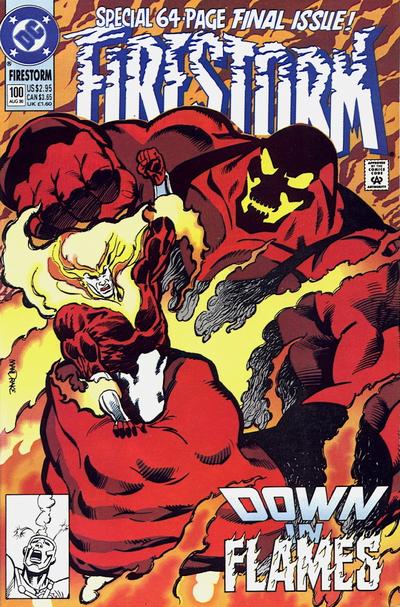
AFTER FIRESTORM
FF: Have you kept up with the changes Firestorm has been through? If so, any thoughts on that direction?
JO: I know OF them but I really haven’t been keeping track. When I walk away from something I try not to look back.
FF: I’ve always been impressed with your ear for dialogue. You are always spot-on, regardless of whether it’s a god or a regular person. Do you ever struggle with dialogue? How do you find the right voice?
JO: I was in theater for many years before I became a comic-book writer. As part of that, I studied Improvisation with Del Close. Plus I have a fair ear for mimicry. I “hear” the characters in my head as I write them so that helps a lot. I wrote plays before I wrote comics so that taught me how to write character into the dialogue. A lot of it is finding a cadence for a character – that reads well on the page. People may not be aware of it but they notice it. Another trick is to “cast” your character’s voice – they don’t have to match physically but they should vocally. It’s as if you were casting an animated version of the characters. It doesn’t just have to be actors, either. You could use a friend or relative’s voice just as easily. They don’t have to be alive, either. Just a voice you can “hear” in your head and then assign it to a character. That can really help.
FF: If you had the ability to change one thing about the comic book industry, what would it be?
JO: I’d make sure I had more work to begin with.  Seriously – a lot of people in the industry suffer without health care. I’d love to see the industry find a way to let freelancers buy into corporate health insurance at reasonable rates.
Seriously – a lot of people in the industry suffer without health care. I’d love to see the industry find a way to let freelancers buy into corporate health insurance at reasonable rates.
FF: Yourself excluded, are there any contemporary writers that are carrying your torch?
JO: I don’t know if they are necessarily carrying my torch but there are a slew of REALLY good writers in the industry today, people whose work I admire. Gail Simone, Geoff Johns, Brian Michael Bendis, Peter Tomasi, Grant Morrison (IMO, his Ultimate Superman was the QUINTESSENTIAL Superman) Kurt Busiek (loves me that ASTRO CITY), J. Michael Straczynski. Ed Brubaker, Greg Rucka, Mike Mignola, Joss Whedon and so many others. Anyone I’ve neglected to mention, please forgive me. I recently collaborated with Rick Remender, Stuart Moore, and Rob Williams on a miniseries over at Marvel called ONE MONTH TO LIVE. Really collaborative and all the guys (and the editor, Steve Wacker, and his assistant, Alejandro Arbona) really worked well together and made the series, for me, very memorable.
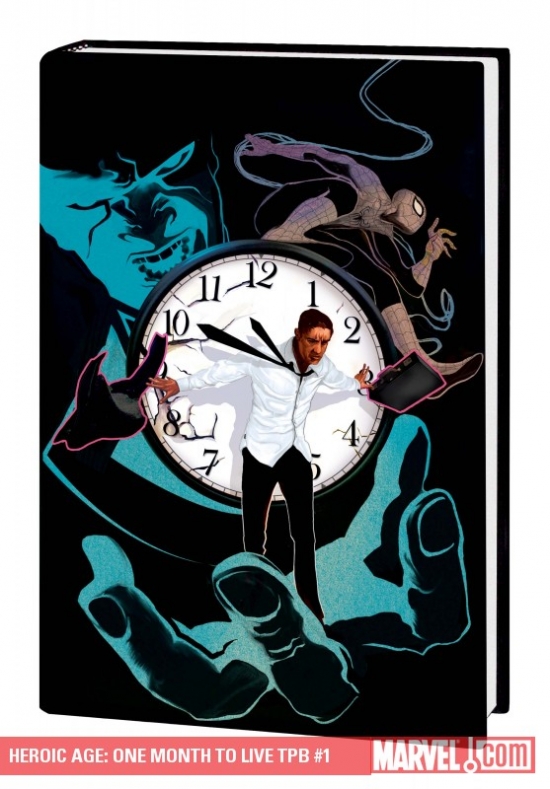
FF: Looking back at the work you’ve amassed, what are you most proud of? What do you consider a high point both personally and creatively?
JO: Beside FIRESTORM? GRIMJACK, SUICIDE SQUAD, WASTELAND, THE KENTS, BLAZE OF GLORY and APACHE SKIES (two Westerns I did at Marvel), THE SPECTRE, HEROES FOR HIRE, my STAR WARS work, BATMAN: GOTHAM NIGHTS, BATMAN: SEDUCTION OF THE GUN, the BLACKHAWKS SPECIAL I did, MARTIAN MANHUNTER, and HAWKWORLD. I don’t think I could pick among them.
FF: What would be your dream comic book project?
JO: Every project is my dream project.
FF: Finally, what are you working on now?
JO: For almost the past decade, I’ve been doing STAR WARS comics with Jan Duursema. In particular, the past few years we’ve been doing STAR WARS: LEGACY which jumps everything down the time line about 140 years from the end of A NEW HOPE (the original Star Wars movie for those who need clarifying). We’ve been dealing with Luke Skywalker’s descendant, Cade Skywalker, a different Empire and lots of new Sith. We’re now winding it up with a six issue miniseries – STAR WARS LEGACY: WAR – which has just started. These are just good comics, whether you’re into Star Wars or not. Great characters, great art, lots of action, and tricksy plotting. I think all the back issues are now available in TPB format. After that, Jan and I have another Star Wars project in the works. In the past year, I’ve done some SUICIDE SQUAD/SECRET SIX work with my pal, Gail Simone and, as I mentioned above, ONE MONTH TO LIVE over at Marvel which will be released in hardcover in January and in TPB format sometime later. Some of my GRIMJACK stuff is available in TPB format as well. And I’m always working on new pitches so we’ll see what happens in 2011.
Thanks to John Ostrander for generously donating his time to this interview! Be sure to pick up STAR WARS LEGACY: WAR (issue #2 is on stands now!) as well as other collected works from John Ostrander. To keep up with John, check him out on his message board at the World Famous Comics Community and Facebook. Be sure to visit and tell him FIRESTORM FAN sent you!
Thanks for stopping by and I hope you enjoyed the interview!
Support Firestorm! Fan the flame!
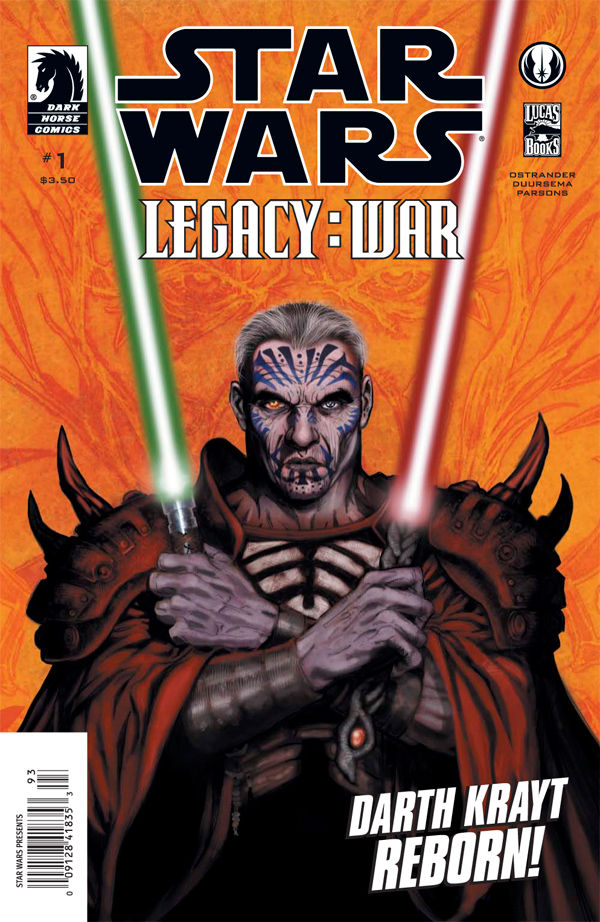
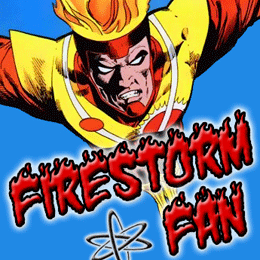
Good interview! (Thanks, John; I loved your Spectre work!)
Remember when big things happened in annuals? Character revamps, Justice League disbandments, Sue and Reed getting married . . . You want to show the kids you’re old skool, you tell ’em about the days of important annuals!
[…] MyTeeSpot Firestorm Fan PostsJohn Ostrander: Exclusive Interview with FIRESTORM FANFirehawk by Garrett BlairNuclear on the Net: Musings on FirestormCustom Firestorm PlushFavorite […]
[…] This post was mentioned on Twitter by Speed Force, Irredeemable Shag and Irredeemable Shag, Benjamin Embry. Benjamin Embry said: RT @onceuponageek: Exclusive interview with comics legend John Ostrander on his Firestorm work! http://bit.ly/ePxxSs #comics […]
Great interview, Shag!
Interviewing Ostrander was one of the many highlights I took away from Hawkman Companion. He’s one of those writers I always keep an eye out for and keep hoping to read more from.
Great interview! I agree with John – I like the original fire-hair look better.
I’d like to know how much the mysterious Rasputin character was inspired by the mysterious Constantine, as they both were “advisors” to elementals.
I really enjoyed this interview, Shag. Great job!
Just wanted to chime in on what a great interview this was, Shag. Score!
this is the coolest thing since Joe Jusko leaving a comment on the IADW blog site! i love how so many characters from Firestorm crossed over into the Suicide Squad. i wish i had known that back in the day. it would have been nice to have Ostrander talk a bit about what his motivations were for “recasting” Barbara Gordon from Batgirl to Oracle. i just got done writing a posting for Batgirl/Oracle last night for my Suicide Squad blog, how ironic i should discover this posting about the interview just today.
Thanks, Shag, for a very informative interview.
Nice one Shag, some really good questions
@Greg- apparently use of Constantine was denied by editorial, so Rasputin was created
http://www.qusoor.com/hellblazer/bastard.htm
Great Job, Shag!
Shag, fine interview with Mr. O. To me, his Suicide Squad is still the best “villain” book out there, with Secret Six hot on its heels. And the recent story Mr. O. did for the book just proves it. The combo of him and Gail just works. Here’s hoping someone at DC will pull their heads outta their posteriors and get this man some work.
[…] If you’d like to read more, click here for the FIRESTORM FAN interview with John Ostrander! […]
“Every project is my dream project.”
That’s a great attitude to have.
[…] http://firestormfan.com/2011/01/28/john-ostrander-interview/ […]